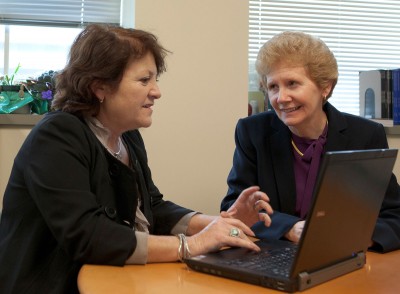
It didn’t take long for New Britain fifth-grade teacher Kim Rosa Gionfriddo to realize the strategies she learned as a Neag School of Education REALL fellow to better teach students with limited English proficiency could benefit native English-speaking students, too.
“It’s a simple thing, but just by being more explicit and taking time to define terms—reminding students, for example, the difference between a product and a quotient—can help keep them focused and ensure they keep up with the lesson, rather than wonder, become confused or fall behind,” said Gionfriddo, one of 45 Connecticut teachers accepted into the graduate-level Raising Expectations for All English Language Learners (REALL) program.
Developed in 2007 by Neag Assistant Professor Eliana D. Rojas, Ph.D., and funded with a $1.5 million grant from the U.S. Department of Education, the REALL program graduated its final fellow this past May. Experts, however, expect the skills and strategies fellows learned to improve ELLs’ academic achievement will have long-term and far-reaching effects.
Focused on science, technology, engineering and mathematics (STEM) teachers working toward their master’s or Sixth Year degrees, the program was designed to contribute to efforts to close Connecticut’s achievement gap. Perhaps more importantly, it was also designed to give teachers the ability to show Latino and other ELL students they aren’t the “failures” standardized tests and assessments say they are.
“ELL students deserve the same opportunities for academic achievement as their English-speaking peers. They have just as many abilities, but many need to be taught differently,” Rojas said. “Similar to students with physical disabilities, ELLs have special needs to be accommodated, and it’s our job as educators to find best practices to do that—to make these students feel passionate about learning, rather than to make the experience of learning frustrating, or to make them feel like failures.”
Emphasizing math, REALL provided fellows with proven ELL teaching models. Strategies and tools for better cross-cultural communications and building a more culturally responsive learning environment were stressed, including web-based technology that allows ELLs to work on their individual challenges. Bilingual math teachers were taught a proven intermediate algebra/pre-calculus teaching model.
REALL fellow Andrea Handler-Ruiz, a science teacher in the Arts & Humanities Academy at Windham High School in Willimantic, walked away from the program with not just more effective teaching strategies, but a “fortified” belief that great teaching is not just about providing an effective education, but an equal education.
“The importance of programs like REALL cannot be overlooked,” Handler-Ruiz said. “The readings and dialogues we took part in showed us how to embrace diversity in the classroom, as well as solidly argue in favor of integrated teaching approaches that best serve multicultural students.”
Rojas, whose continued dedication to strengthening the abilities of ELL educators has made the Neag School of Education a leader in the field, echoed Handler-Ruiz’s beliefs: “How do we target students who face the biggest challenges, without diluting expectations? Materials and standards don’t need to be ‘dumbed down’ for ELLs, but presented differently. REALL gave educators the tools to do the important work they are committed to. And the benefits? The results we’ve seen are that everyone wins.”
 Facebook
Facebook Twitter
Twitter  LinkedIn
LinkedIn
Comments are closed.